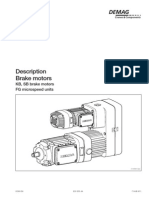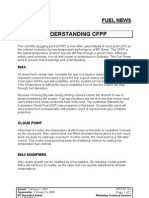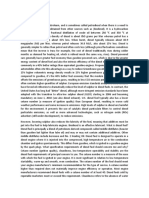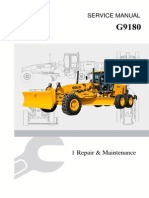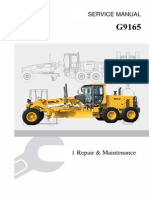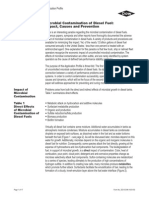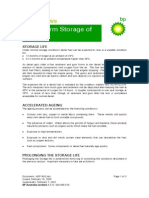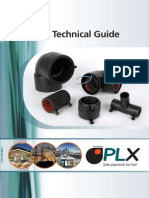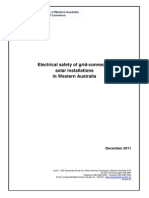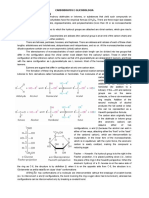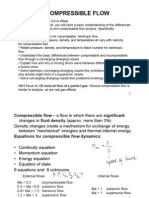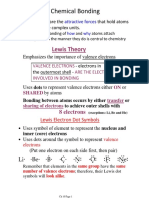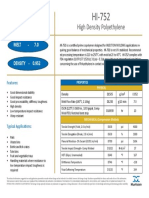0 ratings0% found this document useful (0 votes)
72 viewsChanging Diesel Fuel Properties Using Additives
Changing Diesel Fuel Properties Using Additives
Uploaded by
Rebecca HartmanDiesel fuel additives called cold flow improvers can lower the temperature at which wax crystals form in diesel and cause issues like clogged filters. They work by modifying the size and shape of wax crystals. Testing shows these additives can lower the cold filter plugging point of diesel by up to 3 degrees Celsius and significantly lower the freezing point. For the additives to be effective, they must be thoroughly mixed into the fuel and added before wax separation occurs.
Copyright:
© All Rights Reserved
Available Formats
Download as PDF, TXT or read online from Scribd
Changing Diesel Fuel Properties Using Additives
Changing Diesel Fuel Properties Using Additives
Uploaded by
Rebecca Hartman0 ratings0% found this document useful (0 votes)
72 views2 pagesDiesel fuel additives called cold flow improvers can lower the temperature at which wax crystals form in diesel and cause issues like clogged filters. They work by modifying the size and shape of wax crystals. Testing shows these additives can lower the cold filter plugging point of diesel by up to 3 degrees Celsius and significantly lower the freezing point. For the additives to be effective, they must be thoroughly mixed into the fuel and added before wax separation occurs.
Original Description:
Diesel fuel additives
Copyright
© © All Rights Reserved
Available Formats
PDF, TXT or read online from Scribd
Share this document
Did you find this document useful?
Is this content inappropriate?
Diesel fuel additives called cold flow improvers can lower the temperature at which wax crystals form in diesel and cause issues like clogged filters. They work by modifying the size and shape of wax crystals. Testing shows these additives can lower the cold filter plugging point of diesel by up to 3 degrees Celsius and significantly lower the freezing point. For the additives to be effective, they must be thoroughly mixed into the fuel and added before wax separation occurs.
Copyright:
© All Rights Reserved
Available Formats
Download as PDF, TXT or read online from Scribd
Download as pdf or txt
0 ratings0% found this document useful (0 votes)
72 views2 pagesChanging Diesel Fuel Properties Using Additives
Changing Diesel Fuel Properties Using Additives
Uploaded by
Rebecca HartmanDiesel fuel additives called cold flow improvers can lower the temperature at which wax crystals form in diesel and cause issues like clogged filters. They work by modifying the size and shape of wax crystals. Testing shows these additives can lower the cold filter plugging point of diesel by up to 3 degrees Celsius and significantly lower the freezing point. For the additives to be effective, they must be thoroughly mixed into the fuel and added before wax separation occurs.
Copyright:
© All Rights Reserved
Available Formats
Download as PDF, TXT or read online from Scribd
Download as pdf or txt
You are on page 1of 2
FUEL NEWS
CHANGING DIESEL LOW TEMPERATURE
PROPERTIES USING ADDITIVES
Diesel fuel is refined so that its low temperature properties are fit for the area and
time it is to be used. However unseasonable cold snaps when the temperature
drops below the cloud point of the fuel cause operating difficulties due to wax
dropout.
The cloud point of a diesel fuel can normally only be lowered by the addition of a
product with a lower wax content e.g. Heating Oil and similar products.
However by using additives called cold flow improvers it is possible to lower the
temperature at which the wax crystals will block filters (the Cold Filter Plugging Point
or CFPP) and the temperature at which the diesel freezes (Pour point). These
additives work by changing the size and shape of the wax crystals.
Normally the cold filter plugging point is the same as or 1 to 2 C below the cloud
point while the pour point is 3 to 6 C below the cloud point. With additives it may be
possible to lower the Cold Filter Plugging Point by 1 to 2 C and much more on the
pour point.
Cold flow improvers can be an alternative to adding heating oil to improve the low
temperature properties of diesel but the following precautions must be observed.
EFFECTIVENESS
BP In-house testing has shown that these additives can have only a minor effect on
the cold filter plugging point of diesel fuels made from the local Bass Strait crudes.
But they will still lower the freezing point and stop problems caused by the diesel
freezing solid in lines. Additives will not change cloud point.
The In-house testing has shown that they can lower the cold filter plugging point of
diesel made from imported crude oil by up to 3 degrees even at half the
recommended treat rate.
MIXING
For a cold flow improver to work it must be mixed intimately with the fuel so there
must be no undissolved wax present. It should be added to a tank before the fuel is
put in so that mixing takes place. When adding a cold flow improver the fuel must be
at least 5 to 10 C above its cloud point. It will not fix product in tanks that is
showing signs of wax. Pouring it in the top of a tank in which the wax has dropped
out of the diesel is a waste of time.
DETERGENCY
Commercially available cold flow improvers are often combined with detergents
and other additives and sold as fuel conditioners. If such additives are used in bulk
tanks the detergent in the additive can strip rust and dirt from tanks which may
lead to reduced filter life for a short time until the tanks are clean.
Issued : February 7, 2002 ADF2102.doc
Supersedes : May 24 2001 Page 1 of 2
BP Australia Limited
A.C.N. 004 085 616
Marketing Technical Services
FUEL NEWS
CHANGING DIESEL LOW TEMPERATURE
PROPERTIES USING ADDITIVES
APPLICATION
The cold flow improver can be added to vehicle tanks to provide protection when
vehicles are left overnight. It can also be added to bulk tanks but remember to
dewater the tank first to remove loose water and dirt.
SUPPLIERS OF COLD FLOW IMPROVER ADDITIVES
Additives that are claimed to improve cold flow properties are available from a
number of Commercial Suppliers. A contact for one is supplied below to assist those
who want to use an additive approach for resolving cold weather diesel problems.
Please note that BP does not endorse nor recommend any one particular supplier,
customers should choose suppliers according with their own requirements.
Additive :- ROX DIESEL ANTIFREEZE FUEL ADDITIVE
Supplied by :- National Petroleum Equipment
Freecall 1800 028 283.
Treat rate Recommended treat rate is 1 litre of additive in 500 litres of diesel but we
have found that 1 litre in 1000 litres of diesel will lower the cold filter plugging point by
3 to 5 C in BP manufactured diesel. It will also lower diesel pour point (freezing
point) by more than 10 degrees, but It will not change cloud point.
IMPORTANT NOTE This product also contains a detergent additive so
precautions against dirt and water pickup should be taken by dewatering tanks
before dosing the product.
In terms of its impact on cold flow properties it is equivalent to the addition of 25%
Heating Oil except it will not lower the temperature at which wax crystals separate
out, it will only modify the crystals to reduce the tendency to block filters.
Application
Ideal where the problem is that fuel is freezing in lines, it will stop the freezing.
Where the problem is wax crystals blocking filter, then its effectiveness may be
limited by crude type. May not be so effective in Victoria and Tasmania due to the
refineries using Gippsland crude oil.
For further information, please call the
BP Lubricants and Fuels Technical Helpline
1800 033 558
freecall
or visit www.bp.com.au/fuelnews
Issued : February 7, 2002 ADF2102.doc
Supersedes : May 24 2001 Page 2 of 2
BP Australia Limited
A.C.N. 004 085 616
Marketing Technical Services
You might also like
- 0F9765Mnl: Engine Parts ManualDocument28 pages0F9765Mnl: Engine Parts ManualMartin Valdez100% (2)
- PDFDocument44 pagesPDFRebecca Hartman75% (4)
- 95-1132-01 - Formulation Information - Auto Care ApplicationsDocument40 pages95-1132-01 - Formulation Information - Auto Care ApplicationsUday Edapalapati100% (1)
- Iso 8217Document33 pagesIso 8217PrasannaNo ratings yet
- Acondicionador Combustible DieselDocument6 pagesAcondicionador Combustible DieselGustavo GonzalezNo ratings yet
- Fuels Winter Understanding CFPPDocument2 pagesFuels Winter Understanding CFPPNenad PopovicNo ratings yet
- Special To Seaway ReviewDocument10 pagesSpecial To Seaway ReviewabdelhaiNo ratings yet
- SEBU6251Document15 pagesSEBU6251Scribd ForfreeNo ratings yet
- Maintaining Diesel Engines For Reliable Operation: BackgroundDocument5 pagesMaintaining Diesel Engines For Reliable Operation: BackgroundBurce MherjheNo ratings yet
- Distillation and Vapor Pressure Test of Gasoline Fuel: Fuels TestedDocument3 pagesDistillation and Vapor Pressure Test of Gasoline Fuel: Fuels TestedReyes, Ishmael Edward John U.No ratings yet
- Maintenance Products Fuel SpecificationsDocument8 pagesMaintenance Products Fuel Specificationssoelist teoNo ratings yet
- Maintenance Products Fuel SpecificationsDocument8 pagesMaintenance Products Fuel Specificationssoelist teoNo ratings yet
- OS 04 Diesel FuelDocument15 pagesOS 04 Diesel FuelSarno MukriNo ratings yet
- Winter Diesel FaqDocument2 pagesWinter Diesel FaqRebecca HartmanNo ratings yet
- Amsoil Diesel Cold Flow (Add)Document2 pagesAmsoil Diesel Cold Flow (Add)amsoildealerNo ratings yet
- 99710-36130-12 - Service DataDocument11 pages99710-36130-12 - Service Dataasri novhandiNo ratings yet
- Service Data Forklift GP40N-GP55NDocument8 pagesService Data Forklift GP40N-GP55Nirsan pratama putra100% (1)
- 5 Test SpecificationsDocument6 pages5 Test SpecificationsMarie CloudNo ratings yet
- Midw Technology As A Drop-In Catalyst SolutionDocument11 pagesMidw Technology As A Drop-In Catalyst Solutiondie_1No ratings yet
- Section 5 - Fuel, Lubricating Oil, and CoolantDocument11 pagesSection 5 - Fuel, Lubricating Oil, and CoolantRamon100% (1)
- Taller N.2 Petroleum DieselDocument2 pagesTaller N.2 Petroleum DieselNICOLASNo ratings yet
- BiodieselFuelQuality NelsonDocument43 pagesBiodieselFuelQuality NelsonManisha JourwalNo ratings yet
- Fuel SpecificationsDocument2 pagesFuel Specificationsma.powersourceNo ratings yet
- Diesel High Speed Diesel SpecificationsDocument8 pagesDiesel High Speed Diesel SpecificationsSuman Chatterjee100% (1)
- Biodiesel Fuel: ASTM Standard For Biodiesel (ASTM D6751)Document7 pagesBiodiesel Fuel: ASTM Standard For Biodiesel (ASTM D6751)Jaffarudin Janu WahyudiNo ratings yet
- Section 1Document38 pagesSection 1EdisonNainggolanNo ratings yet
- Fluid RecommendationsDocument6 pagesFluid RecommendationsAlfredoNo ratings yet
- Mod5 Biodiesel PDFDocument32 pagesMod5 Biodiesel PDFBHARATHNo ratings yet
- Lectuer 4Document15 pagesLectuer 4Shakeel MohmandNo ratings yet
- ECP 4204practical 1and 2Document6 pagesECP 4204practical 1and 2Malven MhangaNo ratings yet
- Page 037Document1 pagePage 037kien nguyenNo ratings yet
- SBS 1 - RequirementsDocument4 pagesSBS 1 - Requirementsmaior_n7097No ratings yet
- Wirtgen+machine Seriola+1510Document8 pagesWirtgen+machine Seriola+1510Nunnun NaezNo ratings yet
- HPR Diesel 20w-60 (Mineral)Document2 pagesHPR Diesel 20w-60 (Mineral)faisiiNo ratings yet
- Petroleum Refinery: Soran University Petroleum Engineering DepartmentDocument31 pagesPetroleum Refinery: Soran University Petroleum Engineering DepartmentHemenMoNo ratings yet
- Lubricating A Modified CarDocument1 pageLubricating A Modified CarYudha RahmanNo ratings yet
- Product Data: Antifreeze NFDocument5 pagesProduct Data: Antifreeze NFJaya PranataNo ratings yet
- 1repair & Maintenance - ENGLISG-G9180Document44 pages1repair & Maintenance - ENGLISG-G9180George Jhonson100% (5)
- 210-Titan PSW 15Document2 pages210-Titan PSW 15jafaristsNo ratings yet
- 109 Fuel AdditivesDocument4 pages109 Fuel Additivesalwan61100% (1)
- 1repair & Maintenance - ENGLISG-G9165Document39 pages1repair & Maintenance - ENGLISG-G9165George Jhonson100% (6)
- Enviro+ DPF Cleaner: Product Code Pack Size Carton QtyDocument2 pagesEnviro+ DPF Cleaner: Product Code Pack Size Carton QtyGary LittleNo ratings yet
- 34 SGDocument6 pages34 SGJeanne TaylorNo ratings yet
- Damaged by Fuel SulfurDocument4 pagesDamaged by Fuel Sulfurbambang eengNo ratings yet
- Delvac XHP Le 10w-40Document2 pagesDelvac XHP Le 10w-40angel de mi guardaNo ratings yet
- LUB OILS NOHAB W25 W25SG W25DF 9193911800eDocument2 pagesLUB OILS NOHAB W25 W25SG W25DF 9193911800eLIVIA100% (2)
- Cooling Water and Additives For WinGD Engines v4Document9 pagesCooling Water and Additives For WinGD Engines v4Prabin 7906No ratings yet
- Fluid Recommendations ###Document5 pagesFluid Recommendations ###benjir shuvoNo ratings yet
- Guidelines On Operation On Distillate Fuels: Service Letter SL09-515/CXRDocument5 pagesGuidelines On Operation On Distillate Fuels: Service Letter SL09-515/CXRginanjarNo ratings yet
- Moving Towards Cleaner FuelsDocument16 pagesMoving Towards Cleaner FuelsEnviro_PakNo ratings yet
- Volume IDocument241 pagesVolume IEduardo Casarrubias VillanuevaNo ratings yet
- It Is Important That You Understand What API CJ-4 Lube Oil Is (And Isn't), and Why It Was DevelopedDocument2 pagesIt Is Important That You Understand What API CJ-4 Lube Oil Is (And Isn't), and Why It Was Developedvoyager1No ratings yet
- Approved Lubrication DDocument2 pagesApproved Lubrication DMostafa MohamedNo ratings yet
- Maintenance Intervals - Sebu8593-01 M (Tra)Document84 pagesMaintenance Intervals - Sebu8593-01 M (Tra)Miguel RodriguezNo ratings yet
- Aceites para Refrigeracion EmkarateDocument4 pagesAceites para Refrigeracion EmkarateLu KaNo ratings yet
- BoatWorks Diesel TipsDocument4 pagesBoatWorks Diesel TipsloloNo ratings yet
- Taro 30 DP PDFDocument3 pagesTaro 30 DP PDFHassan KhalifeNo ratings yet
- How to Power Tune Harley Davidson 1340 Evolution Engines: For Road & TrackFrom EverandHow to Power Tune Harley Davidson 1340 Evolution Engines: For Road & TrackNo ratings yet
- Machinery Oil Analysis & Condition Monitoring : A Practical Guide to Sampling and Analyzing Oil to Improve Equipment ReliabilityFrom EverandMachinery Oil Analysis & Condition Monitoring : A Practical Guide to Sampling and Analyzing Oil to Improve Equipment ReliabilityRating: 3.5 out of 5 stars3.5/5 (5)
- Winter Diesel FaqDocument2 pagesWinter Diesel FaqRebecca HartmanNo ratings yet
- Microbes in FuelDocument2 pagesMicrobes in FuelFederico LeonNo ratings yet
- Microbial Contamination of Diesel Fuel: Impact, Causes and PreventionDocument17 pagesMicrobial Contamination of Diesel Fuel: Impact, Causes and PreventionRebecca HartmanNo ratings yet
- Long Term Storage ADFDocument3 pagesLong Term Storage ADFRebecca HartmanNo ratings yet
- Microbial Contamination of Diesel Fuel: Impact, Causes and PreventionDocument17 pagesMicrobial Contamination of Diesel Fuel: Impact, Causes and PreventionRebecca HartmanNo ratings yet
- Durapipe PLX Technical BrochureDocument68 pagesDurapipe PLX Technical BrochureRebecca HartmanNo ratings yet
- MTU427 Generator Set Ratings 082113Document6 pagesMTU427 Generator Set Ratings 082113Rebecca HartmanNo ratings yet
- Report On The SafetyDocument8 pagesReport On The SafetyRebecca HartmanNo ratings yet
- Famco Emergency LightingDocument16 pagesFamco Emergency LightingRebecca HartmanNo ratings yet
- Casar Steel Wire Ropes LetterDocument34 pagesCasar Steel Wire Ropes LetterAnonymous t0r2yT4No ratings yet
- Ssi Schaefer Container AsDocument8 pagesSsi Schaefer Container AsRebecca HartmanNo ratings yet
- Road Construction Cost Estimating ManualDocument115 pagesRoad Construction Cost Estimating ManualRebecca Hartman63% (8)
- Lincoln - General Lubrication ProductsDocument103 pagesLincoln - General Lubrication ProductsRebecca Hartman100% (1)
- Full Priefert Equine Products 2011Document10 pagesFull Priefert Equine Products 2011Rebecca HartmanNo ratings yet
- Final USBR Cost Estimating ManualDocument76 pagesFinal USBR Cost Estimating ManualRebecca HartmanNo ratings yet
- Final USBR Cost Estimating ManualDocument76 pagesFinal USBR Cost Estimating ManualRebecca HartmanNo ratings yet
- A ChargerDocument17 pagesA ChargerRebecca HartmanNo ratings yet
- LT230T Transfer Box Overhaul ManualDocument82 pagesLT230T Transfer Box Overhaul ManualjunglemistNo ratings yet
- Atlas Engineering Metals HandbookDocument136 pagesAtlas Engineering Metals HandbookMatt Kurtze100% (1)
- Confined Spaces: Health and Safety Guidance NoteDocument13 pagesConfined Spaces: Health and Safety Guidance NoteWaleed MorsyNo ratings yet
- Biology Paper 6 NotesDocument5 pagesBiology Paper 6 NotesbNo ratings yet
- STPM 2020 Sem 1 Mock AnsDocument2 pagesSTPM 2020 Sem 1 Mock AnsNicole LimNo ratings yet
- Summary Carbohydrates and GlycobiologyDocument3 pagesSummary Carbohydrates and GlycobiologyIvan MiglioriniNo ratings yet
- 01 Mechanical Properties of Materials Jan09 StdNotesDocument34 pages01 Mechanical Properties of Materials Jan09 StdNotesRusYz AvVeroezNo ratings yet
- Compressible Flow 1Document52 pagesCompressible Flow 1Corey ThomsonNo ratings yet
- Osmosis and DialysisDocument1 pageOsmosis and DialysisNicole PastoresNo ratings yet
- An Experimental Verification of Saturated Salt Solution-Based Humidity Fixed PointsDocument17 pagesAn Experimental Verification of Saturated Salt Solution-Based Humidity Fixed PointsRODRIGONo ratings yet
- 135355-01-REP-06-012 - Update 19.5Document28 pages135355-01-REP-06-012 - Update 19.5Bui Khoi NguyenNo ratings yet
- Choi ThesisDocument86 pagesChoi ThesisAlex CostaNo ratings yet
- Variables Related To Materials and Preparing For Bond Strength Testing Irrespective of The Test ProtocolDocument7 pagesVariables Related To Materials and Preparing For Bond Strength Testing Irrespective of The Test ProtocolMelba RomNo ratings yet
- Chapter 10: Chemical Bonding: Lewis TheoryDocument16 pagesChapter 10: Chemical Bonding: Lewis TheoryDeccanNo ratings yet
- Preparation of Ceramic Powders: 2.1 Introduction and BackgroundDocument46 pagesPreparation of Ceramic Powders: 2.1 Introduction and BackgroundLukmanCibroNo ratings yet
- High Density Polyethylene: Melt - 7.0Document1 pageHigh Density Polyethylene: Melt - 7.0Plastex EcuadorNo ratings yet
- (Doi 10.1002 - 9780470638859.conrr393) Wang, Zerong - Comprehensive Organic Name Reactions and Reagents - Lieben Iodoform ReactionDocument4 pages(Doi 10.1002 - 9780470638859.conrr393) Wang, Zerong - Comprehensive Organic Name Reactions and Reagents - Lieben Iodoform ReactionSachin PrakashNo ratings yet
- The Weld Nugget: WJM TechnologiesDocument3 pagesThe Weld Nugget: WJM TechnologiesSathish KumarNo ratings yet
- Hot-Melt Extrusion Microencapsulation of Quercetin For Taste-Masking.Document10 pagesHot-Melt Extrusion Microencapsulation of Quercetin For Taste-Masking.Chus Otto BellostaNo ratings yet
- Chemsheets Redox QPDocument7 pagesChemsheets Redox QPmichaelcjl123No ratings yet
- Che 329 - Lectre - 2Document95 pagesChe 329 - Lectre - 2anandseshadri901No ratings yet
- Solved 2024 Specimen Paper ICSE Class 10 ChemistryDocument11 pagesSolved 2024 Specimen Paper ICSE Class 10 ChemistrymmroyalethegreatNo ratings yet
- 2695 SpecificationDocument3 pages2695 SpecificationxerxeshakaNo ratings yet
- Lab ReportsDocument18 pagesLab ReportsLana RaedNo ratings yet
- Hydraulic HoseDocument86 pagesHydraulic Hosekselvan_1No ratings yet
- Amr2013 065 06 060802Document53 pagesAmr2013 065 06 060802Jelena Blagojevic-IgnjatovicNo ratings yet
- Metz 7K: Potassium Silicate CementDocument2 pagesMetz 7K: Potassium Silicate CementsonalisabirNo ratings yet
- O F F I O F O F I F F O: Chem 64 PS 2 Solutions Problem 4.1. IFDocument3 pagesO F F I O F O F I F F O: Chem 64 PS 2 Solutions Problem 4.1. IFsara britoNo ratings yet
- Liebherr Brochure Lubricants enDocument20 pagesLiebherr Brochure Lubricants enCristhian EstebanNo ratings yet
- Origin, Generation, Migration and Accumulation of OilDocument22 pagesOrigin, Generation, Migration and Accumulation of Oilrahulme43No ratings yet
- Two MBR Case StudiesDocument17 pagesTwo MBR Case StudieszizitroNo ratings yet
- Kittiwake MAK19643PA Oil Test Centre DatasheetDocument4 pagesKittiwake MAK19643PA Oil Test Centre DatasheetCorina StanculescuNo ratings yet

